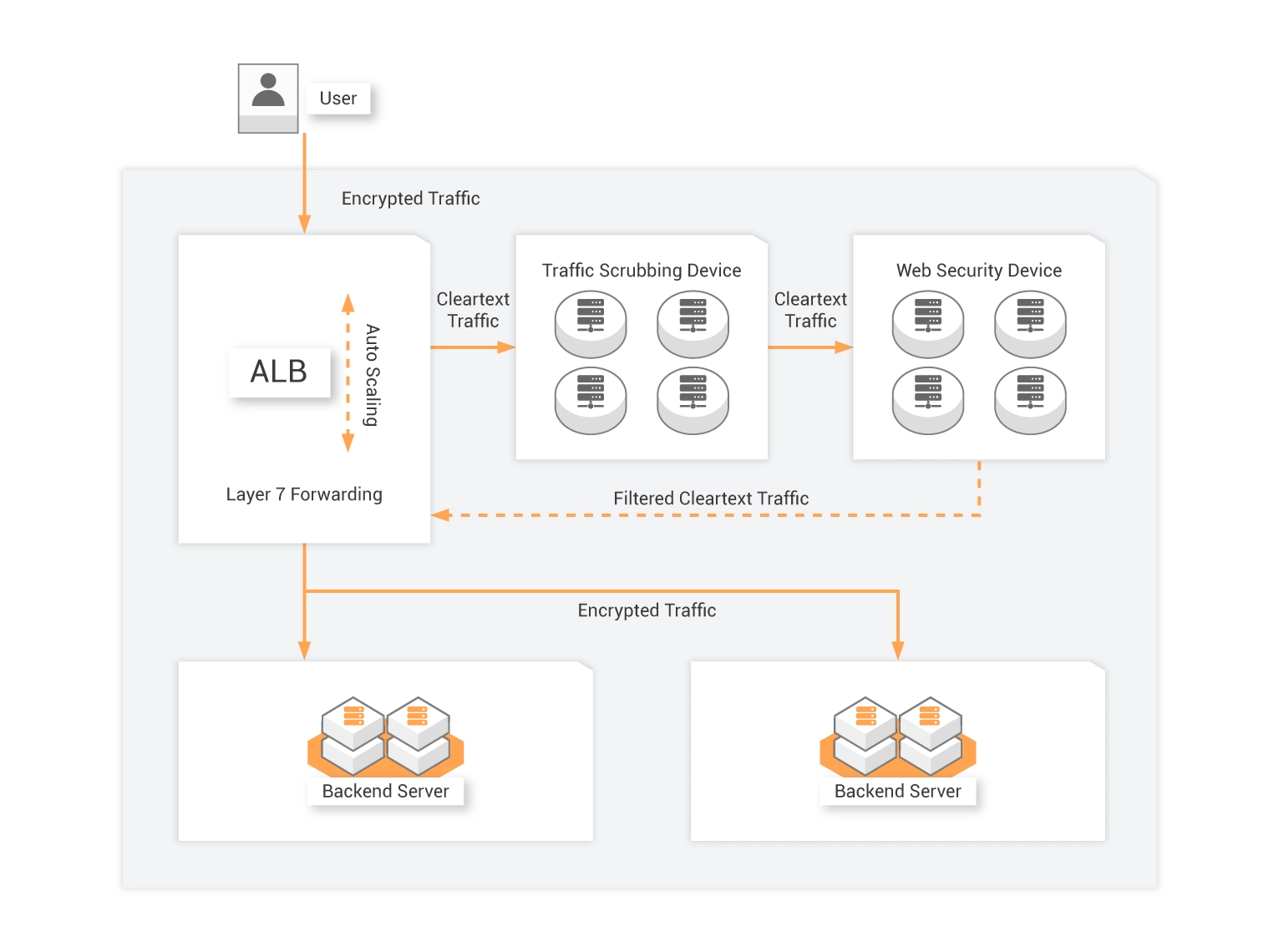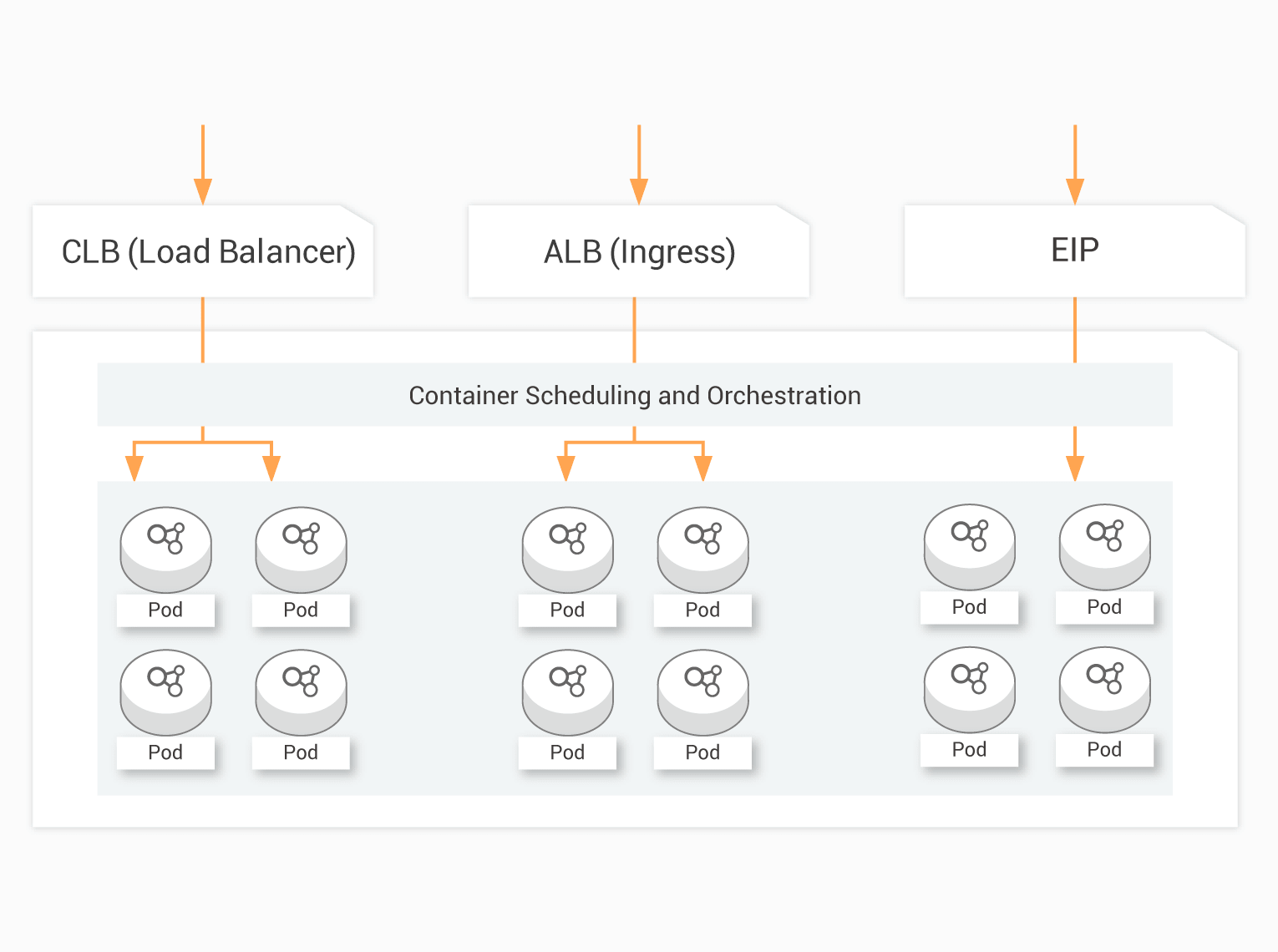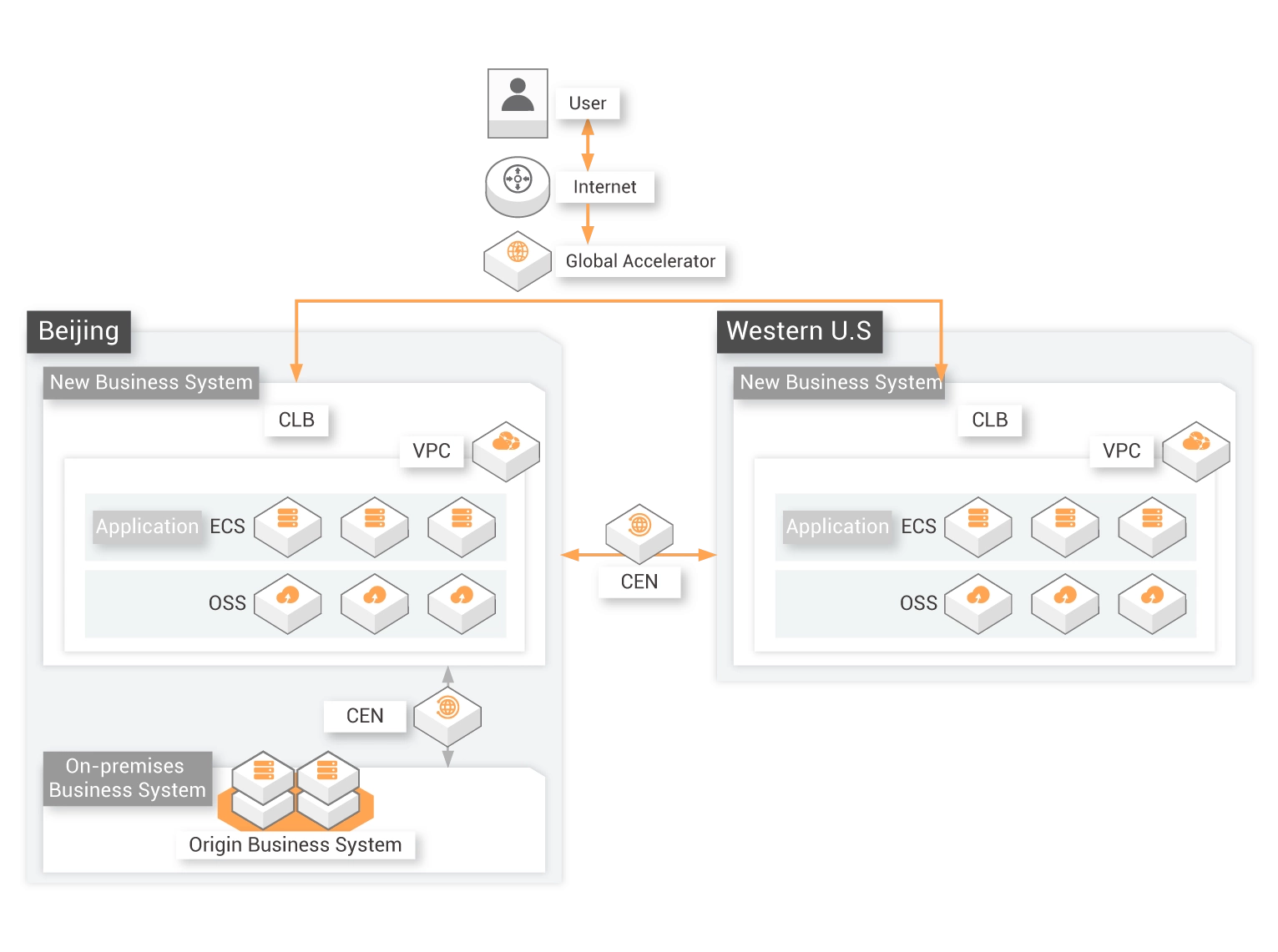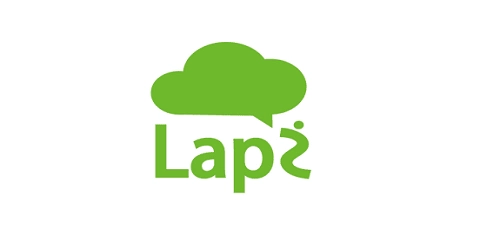Latest News
Application Load Balancer (ALB) Supports Web Application Firewall (WAF) 3.0 Service Access
Learn MoreIndividuals receive a USD $15 and Enterprise receive a USD $55 Classic Load Balancer (CLB) credit
Learn MoreNetwork Load Balancer (NLB) Has Been Officially Commercially Available, Free of Instance Fees for Limited Time, Welcome to Experience
Learn MoreHigh Performance and Elasticity
Stable, Reliable, and Cloud-Native
Server Load Balancer (SLB) provides high-performance load balancing services. with super four-seven processing capabilities.Network Load Balancer (NLB) Provides powerful processing capabilities at Layer 7,A single NLB instance supports 100 million concurrent connections. The newly released Application Load Balancer (ALB) service is based on Alibaba Cloud Apsara Network 2.0 and supports up to 1,000,000 QPS.
The Server Load Balancer (SLB) instances feature high performance and support auto scaling. They can automatically adjust resources based on your business requirements to simplify O&M.
High Security and Reliability
Server Load Balancer (SLB) provides disaster recovery at four levels for high availability. CLB and ALB support built-in Anti-DDoS services to ensure business security. In addition, you can integrate ALB with WAF in the console to ensure security at the application layer.
Multiple Protocols
Server Load Balancer (SLB) supports multiple protocols, such as TCP, UDP and TCPSSL at the network layer, and HTTP, HTTPS, QUIC, and gRPC at the application layer. NLB provides large-scale SSL offloading capabilities,ALB provides multiple advanced routing features at Layer 7.
Cloud-Native
ALB and CLB support cloud-native networks. ALB is integrated with other cloud-native services, such as Container Service for Kubernetes (ACK), Serverless App Engine (SAE), and Kubernetes, and functions as a cloud-native gateway to distribute inbound network traffic.
SLB Types
`| Type | Network Load Balancer (NLB) | Application Load Balancer (ALB) | Classic Load Balancer (CLB) |
|---|---|---|---|
| Service Scope |
Provides powerful processing capabilities at Layer 4 and large-scale SSL offloading capabilities Intended for TCP, UDP and SSL over TCP Focuses on network delivery |
Provides powerful processing capabilities at Layer 7 and multiple advanced routing features Supports HTTP, HTTPS, and QUIC at Layer 7 Focuses on application delivery |
Provides powerful processing capabilities for Layer 4 load balancing Supports protocols such as TCP, UDP, HTTP, and HTTPS Focuses on network delivery |
| Performance |
Based on the NFV platform and auto scaling A single NLB instance supports 100 million concurrent connections |
Based on the NFV platform and auto scaling A single ALB instance supports 1,000,000 QPS |
Developed on top of a physical machine architecture Supports up to 5,000,000 connections |
| O&M | Supports auto scaling to adjust processing capabilities based on inbound traffic | Supports auto scaling to adjust processing capabilities based on inbound traffic | Provides multiple specifications that you can specify based on the traffic peaks in your business |
| Cloud-Native Support | Supports cloud-native services | Serves as a cloud native gateway to distribute and mirror network traffic and supports canary release and blue-green deployment | Supports cloud-native services |
| Scenarios |
Supports high concurrency to withstand Layer 4 traffic spikes Serves as an ingress for IoT services such as Internet of vehicles (IoV) Supports cross-zone disaster recovery and serves as an ingress for both on-premises and cloud services |
Provides high-performance services and supports auto scaling at Layer 7 Maintains low network latency for audio and video applications that handle a large amount of network traffic Supports canary release and blue-green deployment for cloud native applications |
Distributes network traffic across backend servers at Layer 4 to ensure the high availability of websites and systems Supports a large number of concurrent connections to backend servers Provides intra-region and cross-region disaster recovery |
| Pricing | NLB Pricing Details > | ALB Pricing Details > | CLB Pricing Details > |
| Getting started | Create a NLB | Create an ALB | Create a CLB |
Features
Multiple Protocols
Supports multiple protocols to meet your business requirements in various scenarios.
Basic Protocols
Supports Layer 4 load balancing over TCP or UDP and Layer 7 loading balancing over HTTP or HTTPS
Advanced Protocols
Supports QUIC at the application layer. QUIC is an advanced protocol that improves transmission on audio, video, and mobile applications. ALB also supports gRPC, which facilitates efficient communication among microservices through API operations.
Multi-Level Disaster Recovery
Provides disaster recovery at multiple levels to ensure high availability.
Health Checks
Monitors the condition of backend servers regularly. SLB does not distribute network traffic to unhealthy backend servers to ensure availability.
Multi-Zone Deployment
Supports multi-zone deployment in specific regions to provide zone-disaster recovery.
Cluster Deployment and Session Synchronization
Server Load Balancer (SLB) supports cluster deployment and session synchronization. You can perform hot upgrades and monitor the health and performance of machines in real-time.
Secure and Reliable
Provides built-in security capabilities (free of charge) to secure transmission and reduce costs.
Layer 4 Security
Server Load Balancer (SLB) is resilient against DDoS, SYN flood, UDP flood, ACK flood, ICMP flood, and DNS flood attacks at Layer 4.
Layer 7 Security
Provides security capabilities at Layer 4 and Layer 7. Layer 7 supports the configuration read-only mode. You can integrate Server Load Balancer (SLB) with WAF to secure your applications.
Certificate Management
Provides certificate management for HTTPS requests to ensure the reliability and security of the transmission.
Flexible Scheduling
Supports multiple scheduling algorithms and forwarding methods to improve the application deployment flexibility.
Scheduling Algorithms
Supports Weighted Round Robin (WRR) and Weighted Least Connection (WLC). You can specify scheduling algorithms to distribute network traffic based on your business requirements.
Domain Name and URL Forwarding
Distributes network traffic across backend servers based on domain names and URLs. This improves the application deployment flexibility.
Flexible Management and Billing
Allows you to specify the instance type and billing method based on your business requirements. Alibaba Cloud also provides multiple methods to manage your Server Load Balancer (SLB) service.
Flexible Billing
Supports the pay-as-you-go and subscription billing methods and the pay-by-data-transfer and pay-by-bandwidth metering methods.
Flexible Management
You can create, configure, and manage Server Load Balancer (SLB) instances in the console by calling APIs in OpenAPI or using Alibaba Cloud SDKs.
Scenarios

Challenges
Workloads on backend servers are heavy during peak hours in the audio, video, and game industries:
• A large amount of network traffic is forwarded between clients and backend servers in scenarios, such as short videos, long videos, livestreaming, online education, and online games.
• Large traffic fluctuations occur in audio and video scenarios. This affects the performance, elasticity, stability, and availability of systems.
Benefits
-
High Performance
Supports Cloud Network Management 2.0. A single SLB instance supports 1,000,000 QPS.
-
High Elasticity
SLB automatically adjusts its processing capabilities based on the inbound traffic. You do not need to configure the service manually.
-
Advanced Protocol
Supports QUIC to facilitate transmission for videos and reduce First Contentful Paint (FCP) time.
Alibaba Cloud CDN
A highly scalable and cost-effective service to accelerate content delivery.
Learn MoreTair (Redis® OSS-Compatible)
A fully-managed cloud database service that supports Redis®.
Learn More
Requirements
Frequent business adjustment occurs in scenarios, such as new retail, new finance, product releases, and large-scale promotions.
Services must be secure, reliable, elastic, and ready to use after they are activated.
You must provide flexible billing to reduce costs.
Benefits
-
Ready-to-use
You do not need to purchase or deploy any hardware. The SLB service is ready to use after it is activated. You can specify billing methods based on your business requirements. This allows you to manage your business flexibly and efficiently.
-
Scalability
SLB automatically adjusts its processing capabilities based on inbound traffic. You do not need to configure the service manually in large-scale promotion scenarios.
-
High Security and Reliability
Provides disaster recovery at four levels. SLB supports integration with Anti-DDoS and Cloud Firewall to secure your business.
Elastic Compute Service (ECS)
Provides elastic and secure servers to host your services on the cloud.
Learn MoreWeb Application Firewall (WAF)
Defends websites from common attacks at the application layer to ensure security and availability.
Learn MoreCloud Enterprise Network (CEN)
A global network that consists of interconnected hybrid clouds and distributed systems.
Learn More
Requirements
Enterprises from the Internet, finance, and enterprise sectors want to use advanced cloud-native technologies to deploy their new businesses on the cloud or adjust their current businesses.
You must use the cloud-native SLB service to use ACK, SAE, or Kubernetes.
Benefits
-
Cloud-Native
Integrated with ACK, SAE, and Kubernetes. SLB functions as a cloud-native gateway on Alibaba Cloud to distribute inbound network traffic.
-
Fully Developed APIs
SLB supports gRPC and provides fully-developed APIs that you can call to manage the connections to a large number of microservices.
Container Service for Kubernetes (ACK)
Provides secure and highly-available container services and supports stable upgrades.
Learn MoreElastic IP Address (EIP)
An independent public IP resource that allows flexible management.
Learn MoreHow It Works

Requirements
Multinational enterprises want to distribute network traffic from different regions across applications and connect their data centers to Alibaba Cloud in a cost-effective way.
They want to build a hybrid cloud or a cross-region network that provides multi-level disaster recovery.
Benefits
-
Support for All Regions
Supports intelligent DNS resolution. Client traffic is directed to the best available IP addresses to accelerate transmission and improve the user experience.
-
Multi-Level Disaster Recovery
SLB provides high availability across regions and zones.
-
Ease of Use
You can use SLB and CEN to build a global network that connects data centers in different regions to Alibaba Cloud in a fast and simplified way.
Global Accelerator (GA)
Provides network acceleration services for your Internet-facing application globally.
Learn MoreCloud Enterprise Network (CEN)
Allows you to build a global network that consists of interconnected hybrid clouds and distributed systems with scalability and communication capabilities at the enterprise level.
Learn MoreObject Storage Service (OSS)
Provides encrypted and secure storage services on the cloud.
Learn MoreRelated Resources
Upgraded Support For You
1 on 1 Presale Consultation, 24/7 Technical Support, Faster Response, and More Free Tickets.

1 on 1 Presale Consultation

24/7 Technical Support

6 Free Tickets per Quarter




















